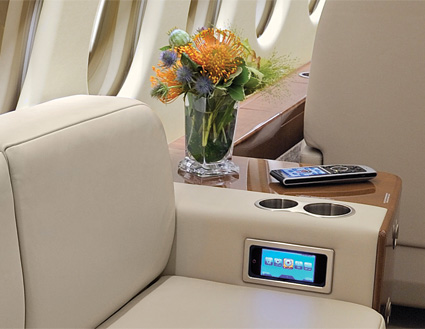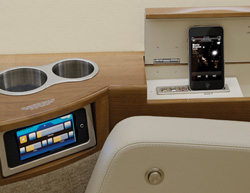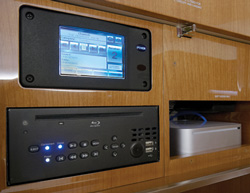
Late last year, a Duncan Aviation committee met for the first time to evaluate new aircraft cabin technologies. These new Cabin Management Systems operate using digital technology to meet the demand for High Definition (HD), Personal Electronic Device (PED) integration, as well as new technologies such as touch-screen control.
Late last year, a Duncan Aviation committee met for the first time to evaluate new aircraft cabin technologies. These new Cabin Management Systems operate using digital technology to meet the demand for High Definition (HD), Personal Electronic Device (PED) integration, as well as new technologies such as touch-screen control.

With these major advancements due to hit the market soon, a team was created to evaluate the options. Quietly pulled together from across Duncan Aviation departments, they gathered to put their vast and varied experience to a focused task: select the best Cabin Management System (CMS) for Duncan Aviation clients.
As anyone who has been through a CMS installation knows, it can be a long, complex process. From the first spec session to designing and engineering the system to ordering the parts, installing them, checking them and training the crew to use them, it can take months to get it right. In the past, long lead times to accommodate engineering and parts availability, along with a multi-week downtime for installation, kept a new Cabin Management System out of reach for many aircraft operators. Thanks to new technology, that is about to change.
“Classic CMSs are the definition of a one-off,” says Justin Vena, a Duncan Aviation Avionics Installations Sales Rep. in Battle Creek, Michigan. “Each installation is unique. In order to become more efficient, focus is required.”
The committee met for the first time and did an initial ranking. The committee of engineers, designers, technicians and product experts looked at the latest offerings from nine manufacturers, evaluating them on 23 key criteria. Criteria included the following:
|
|
|
“I think we were very thorough and thoughtful in our approach to the evaluation,” says Steve Elofson, Duncan Aviation’s Avionics Installation Sales Manager in Lincoln, Nebraska. “We wanted to ensure objectivity while evaluating the things that would really examine what makes a good system for our customers.”

The results of the initial evaluation narrowed the original nine systems down to three. Now it was time for show and tell. The top three systems were brought to Duncan Aviation facilities so the committee could see how they worked and get a real feel for how they would be used inside an aircraft.
“Even with the on-site demo, it was difficult to imagine exactly how the systems would feel inside an aircraft,” says Nate Klenke, a Completions Sales Rep in Lincoln. “To evaluate the functionality and aesthetics, I tried to imagine: What is it like to wake up when it is completely dark and find the switch to turn the light on? What is it like to watch a movie in the forward cabin while someone is using the Xbox in the aft cabin? How easy is it to see and use the switch panel in a specific location? What happens when I lay my pillow on the system? Does my elbow hit it when I’m sitting in the seat? These are some of the issues that tend to arise only after a system is installed and in use.”
Once the committee had a chance to see and touch each system, the final evaluations began in earnest. Every detail was discussed and debated.
“We all had our favorites,” says Justin. “It was interesting to share our varied points of view. All of the systems have very similar benefits. In the end, we’d be happy to install any of them.”
"With focus, we hope to reduce parts lead times by half and slash the total downtime...."
- Justin Vena, Avionics Installation Sales Rep.
But they knew they needed to narrow their selection to one top choice. With advances in technology and by focusing on installing one system a majority of the time, the teams at Duncan Aviation will be able to get very good not only at the installation, but better at designing, engineering and supporting it. The top systems were all designed to make the process easier for customers and installers. The focus on a single system goes beyond that, allowing for a process that will make the design easier and the engineering time shorter– providing a downtime that will make the decision easier for busy aircraft operators.
“With focus, we hope to reduce parts lead times by half and slash the total downtime, putting a CMS installation within the realm of possibility for a standard downtime,” Justin says.
These systems are designed for now and for the future. They are Ethernet-based systems that provide the most-desired entertainment options: HD, Blue-ray capability and Personal Electronic Device (PED) integration. The touch-screen controls are easy and intuitive to use and are easier to customize than ever before. The durability and streamlined box count equals lighter weight, less to install and less to troubleshoot if things go wrong. Perhaps best of all, the capability for future expansion in technology is well-thought out.
"The aircraft cabin is changing, really catching up with what our customers experience in their homes...."
- Justin Vena, Avionics Installation Sales Rep.
“It is really exciting,” Justin says. “The aircraft cabin is changing, really catching up with what our customers experience in their homes: HD, touchscreen controls and wireless capability. I believe our program will make these systems accessible to more aircraft operators than ever before.”
Or in other words, “The change is, there is no change,” explains Nate. “With today’s technology, the experience a passenger has on a jet shouldn’t change from what we have all come to expect wherever we go. The mobile generation is here and moving at a pace faster than ever. Jet passengers are now expecting it to follow them on the aircraft. Cabin entertainment systems are becoming more and more integrated to the devices all of us carry in our pockets. With this new technology, passengers will be able to experience jet travel without the disappointment of not being connected.”
To find out more about the process and the systems that landed at the top of Duncan Aviation’s list, contact one of our Avionics Experts. You can find them at: www.DuncanAviation.aero/services/tech-reps/contacts.